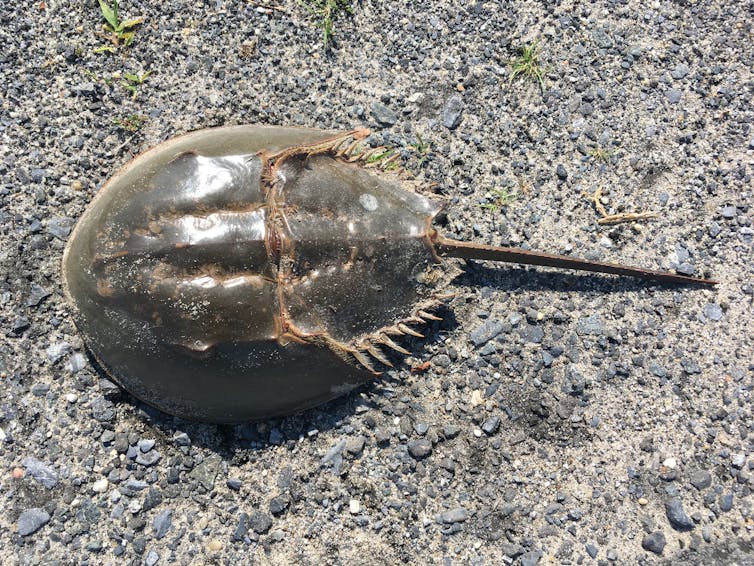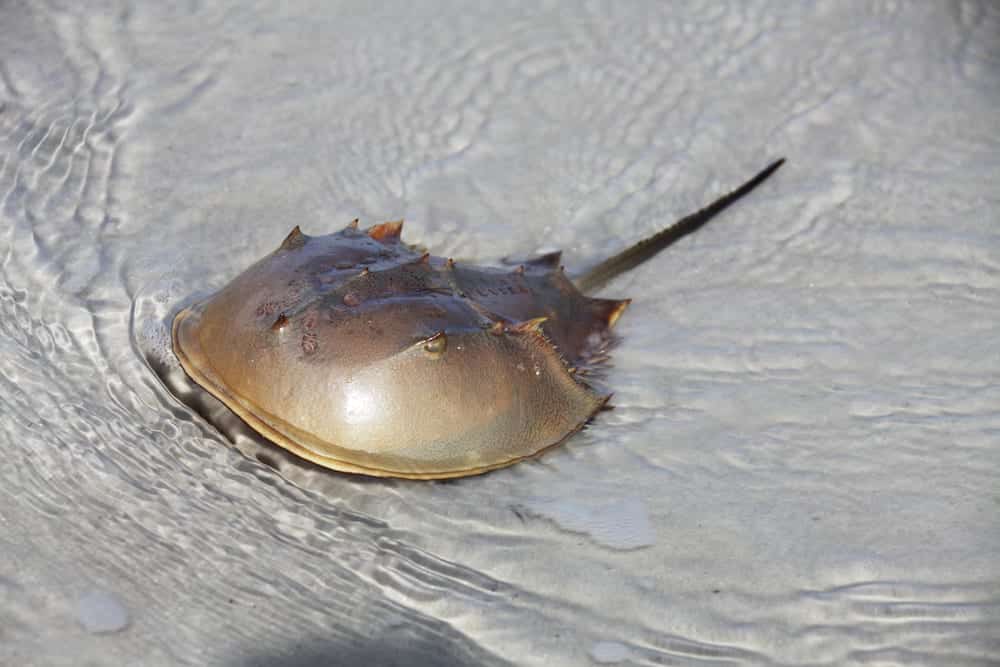Therefore the lifespan of horseshoe crabs may be 17 to 19 years. Horseshoe crabs walked the Earth more than 445 million years ago.
 Living Fossils We Mapped Half A Billion Years Of Horseshoe Crabs To Save Them From Blood Harvests
Living Fossils We Mapped Half A Billion Years Of Horseshoe Crabs To Save Them From Blood Harvests
But it has been put into the vulnerable to extinction category.

How long will a horseshoe crab live. Making the total lifespan of a horseshoe crab as long 20 years. They then hatch into larvae the first immature form of the life cycleHorseshoe crab larvae closely. Horseshoe crabs can live for 20 25 years.
Life Cycle Egg to Infancy. Because of this kiddo horseshoe crabs have to molt. Horseshoe crabs can live to be twenty years old.
One species of Limulus one species of Carcinoscorpius and two. They also found that LAL can be extracted up to 24 times a year from horseshoe crabs that are kept in aquaculture long-term. Horseshoe crabs migrate into the shore in late spring with the males arriving first.
A horseshoe crab can live for more than 20 years. The life span of an individual horseshoe crab is not millions of years but they can live up to 20 years. Taxonomy and distribution There are four species of horseshoe crab divided into three genera.
The team found that the horseshoe crabs maintained their natural behavior and body weight grew consistently survived catheter implantation and thrived for more than 12 months with a zero percent mortality rate. Females deposit eggs into the nests which are subsequently fertilized by the male. They are ready to start breeding and will migrate to coastal beaches in the spring.
Horseshoe crabs dont reach full maturity until approximately age ten and while they do experience consistent growth over those first ten years their carapace their tough exoskeleton that makes them look like tanks doesnt actually grow with them. The body is composed of three parts. Horseshoe crab eggs stay buried in the sand for two to four weeks.
LAL LAL or Limulus Amebocyte Lysate plays an important part bacteria detection and researchers extract it from Horseshoe Crab Scientists use it to detect bacterial contamination of drugs and equipment that come in contact with blood. Egg quantity is dependent on female body size and. How big do horseshoe crabs get.
Videos you watch may be added to the TVs watch history and influence TV recommendations. ExpandCollapse Can a horseshoe crab hurt me. Horseshoe carbs can grow as long as 60cm or.
Some of the different types of habitats. As of right now the horseshoe crab is not on the list of endangered species. They prefer soft substrates like sand or mud.
All of the different species live in shallow habitats. The Horseshoe crab isnt really a crab. Once sexual maturity is reached horseshoe crabs no longer molt or molt rarely.
These strange creatures are characterized by having blue blood and they look as if they had come out of a science fiction movie. Therefore they will molt a maximum of 36 times in their life. Once they stop molting the horseshoe crabs provide an ideal surface to which epifaunal slipper shells Crepidula fornicata can attach themselves.
If playback doesnt begin shortly try restarting your device. Their tails are used as rudders and to right the crab if it. The horseshoe crabs name is derived from the prosoma resembling the shape of a horses shoe.
The females then arrive and make nests at a depth of 15 20 centimetres in the sand. As is often the case the problem is not understanding what it is horseshoe crabs need to survive in captivity. The horseshoe crabs or Limulus polyphemus in scientific terms are the oldest living fossil that exist in our planet with more than four hundred and forty five million years of existence.
It is estimated that their lifespan beyond this point can be up to eight years. Its more closely related to spiders and scorpions than crabs. Horseshoe Crab Life Span and Reproduction.
The prosoma head opisthosoma central area and telson tail. To avoid this cancel. Horseshoe crabs take ten years to reach adulthood and live for about twenty years.
Habitat of the Horseshoe Crab. Horseshoe crabs are an extremely ancient group and are often referred to as living fossils. Can a horseshoe crab hurt me.
Theyve Been Around a Long Time. Wild horseshoe crabs can live for more than forty years but in home aquaria their lifespan is often less than few months. Whether thats sustainable has yet to be determined.
Today all of the species of horseshoe crabs still in existence bear a close resemblance to those crabs. By determining the age of these univalves the age of the horseshoe crab can also be established. Their fossil relatives are recognized as far back as the Ordovician Period 4854 million to 4438 million years ago and forms similar to modern-day horseshoe crabs date back to the Jurassic Period 2013 million to 145 million years ago.
Physical Characteristics The horseshoe crab has a unique and primitive body structure. And do so up to an average of 16 times before reaching maturity.
In the first 23 years of their life the juveniles stay in shallow coastal waters near the breeding beaches. Longevity is difficult to assess but the aver.
 The Atlantic Horseshoe Crab And Covid 19 Qps
The Atlantic Horseshoe Crab And Covid 19 Qps
Horseshoe crab larvae emerge from their nests several weeks after the eggs are laid.

How long can horseshoe crabs be out of water. Changes in horseshoe crabs post-blood loss include a decrease in activity and hemocyanin levels. However many estuaries in which horseshoe crabs spawn have been heavily impacted by pollutants and degraded water quality may be affecting the survival of horseshoe crab eggs laid in such areas. Its spawning is one of the most amazing spectacles in nature.
These larval horseshoe crabs spend about a year on tidal flats where they eat and periodically shed out their shells. An experiment was carried out which consisted in maintaining some horseshoe crabs in tanks for two weeks after being bled. Soak the crab in diluted bleach for about half an hour.
And are out-competing native species for food and space. The most important thing to know is that as long as you pick them up carefully you cannot hurt horseshoe crabs by picking them and returning them to the waters edge. As for the importance of the eggs to creatures under the water we know very little.
Instead they have an impressive array of spiny mouth bristles at the base of five. Abstract It is well established that horseshoe crab eggs can develop successfully across a wide range of temperatures and salinities. The European green crab is a species infamous for surviving out of water for a long timeat least a week.
Crabs stranded on the beach during spawning bury themselves in the sand or fold themselves in half to conserve water until the tide rises again. Horseshoe crabs spawn in the spring at high tide during the new or full. Horseshoe crabs are perhaps best-known for their role in serving up their eggs to hungry shorebirds which time migrations stops to coincide with horseshoe crab spawning.
As young horseshoe crabs grow they move to deeper waters where molting continues. Stay moist horseshoe crabs can remain out of water up to four days. When out of water crabs will seek out dark cool moist places to help prevent their gills from drying out and to hide from predators.
Horseshoe crabs can actually live out of the water for about 4 days. The animals go back into the water mostly unharmed after nearly 30 of their blood is drained over the course of two days but not all horseshoe crabs make it back healthy. A horseshoe crab can live as long as 20 years and some biologists believe the animal can live as long as 30 years.
The young and adult horseshoe crabs spend most of their time on the sandy bottoms of inter-tidal flats or zones above the low tide mark and feed on various invertebrates. Only 5 percent of them died but scientists agree that these are not the same conditions that these crabs face in the ocean although it is a good reference. As they develop they eventually move to deeper waters until they reach sexual maturity 8 to 10 years later and come back to the shore to spawn.
Yet they can still survive for 1-2 days out of the water. They continue to molt regularly. Larval horseshoe crabs travel into the ocean water and settle on the.
The larva looks like a tiny version of an adult horseshoe crab but without a tail. Horseshoe crabs play an important ecological role in the food web for migrating shorebirds and juvenile Atlantic loggerhead turtles. Juvenile horseshoe crabs look a lot like adults except that their tails are smaller.
Horseshoe crabs remain in the juvenile stage for about two years. But maybe the other important thing to know is that you dont have to move them if you are hesitant. These species seem indestructible which is a problem since they have invaded many areas of the US.
During this time they stay in shallow protected water usually close to where they were born. Before becoming sexually mature around age 9 they have to shed their shells some 17 times. If the egg survives the larval horseshoe crab will hatch from the egg after about two weeks or more.
Additionally they can be kept out in the open for long periods of time and may not be able to breathe as a result of the lack of water. Horseshoe crabs have no jaws or teeth. Correspondingly how do you preserve a dead horseshoe crab.
As long as their book gills are kept moist horseshoe crabs can survive out of the water for extended periods of time especially to spawn. However unlike fish blue crabs can survive out of water for long periods of time-even over 24 hours-as long as their gills are kept moist. The surviving eggs hatch after two weeks or more.
Rinse the horseshoe crab shell and let it dry thoroughly. Soak the horseshoe crab in water to loosen up any pieces of junk that may be clinging to the exoskeleton.
ads
